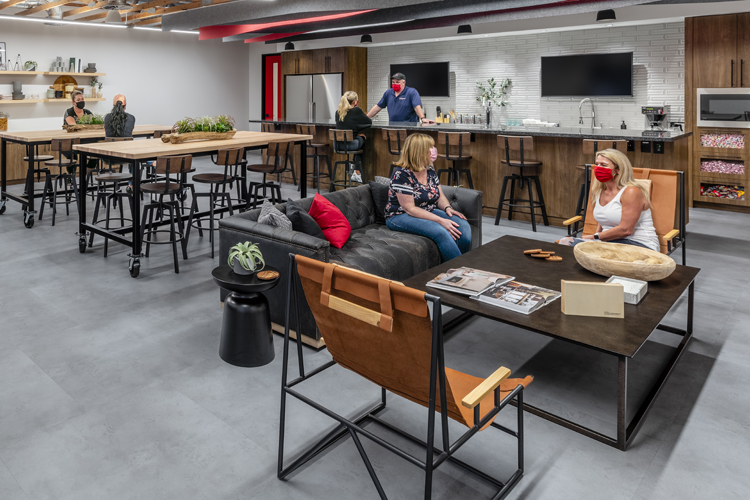There was a general feeling of prosperity and buoyancy in the Phoenix office market a long, long time ago (circa February 2020), but those days are now only fond memories. What has occurred in the proceeding months in the office sector in Arizona and across the United States has profoundly changed how office spaces are utilized and sent the industry into unknown territory.
“The (COVID-19) pandemic has presented new and incredible challenges for millions of workers around the globe,” said NAIOP Arizona member Rory Carder, studio director and workplace leader for Gensler. “In just a matter of weeks, the workforce at large has quickly navigated the sudden shift to remote working, while maintaining the relationship between business continuity and employee well-being.”
For office users, the initial effects of the pandemic created a new reality and new ways of working. The pandemic forced an overwhelming majority of workers to do their jobs from home, and currently, companies are gradually and carefully welcoming their staff back to the office as the spread of COVID-19 slows. NAIOP Arizona members have utilized new tools to continue showing properties to potential tenants, and office designers, tenants and landlords are contemplating just how long this new reality will last into the future.
Carder said that her company had some insight into what was coming down the road in the early part of 2020 as the Coronavirus spread through Asia and Europe. Carder said Gensler used the experience of their international colleagues to make the move to work from home beginning late March.
NAIOP Arizona member Jeff Emmons also sent everyone home from his Immedia Integrated Technologies offices in late March, but that wasn’t the final move.
“We brought everyone back and at the end of June we had someone contract COVID and we sent everyone back home and told them we believed it would be sometime next year before they returned,” said Emmons, who is the founder and CEO of Immedia. “Since our business focuses on audiovisual communication tools, this hasn’t been a huge impact for us.”
“Approximately 75 percent of our offices nationwide are still working 100 percent remotely, said Eric Whitehurst, an associate at Kimley-Horn, which had everyone in its Arizona offices working from home in March. “The offices that have been granted in-person access have all been re-opened on a reduced capacity basis. The reduction factor is being calculated individually based on a per square foot occupancy target along with the staff’s personal appetites to return. Masks and appropriate distancing are mandatory in all offices that have been reopened.”
As more workers are returning to the office, they are returning to a different environment.
“There is a prevalence of sanitizers and signage,” said Michael Hsiung, owner of Valley-based development firm Phoenix Rising Investments. “There’s an awareness of the physical distance between people and the extensive use of flexible schedules and attempting to stagger schedules to ensure a healthy amount of physical distance between people.”
Nate Franke, senior manager of real estate development at The Opus Group, said his company had divided staff into two teams that rotate weeks in the office, with everyone working remotely on Fridays to ensure a three-day window of no one being in the office. Other changes in office protocols include no guests allowed in the office, no handshakes or other forms of contact greeting, health screening protocols and daily disinfecting of the office.
“All associates situated in cubes have been moved to private offices as much as possible,” added Franke. “And people are encouraged to work from home even when they are allowed back into the office.”
Carder said that the biggest challenge is that there is no single approach that works for everyone. She said that Gensler has helped formulate some methodologies that can help companies in their quest to make the office safer for the employees. Those methods include rethinking density to prioritize physical distancing, planning phased scenarios for returning to work, reconfiguring flex spaces and free address spaces, introducing shift work, screening for admittance to the office, and of course, enforcing cleaning regimens to both support services and employees.
While the changes and new policies in place have helped allow more people to return to the office, it is unclear what the longer-term ramifications of the pandemic will be on the office market. The market entered the pandemic in strong shape, with positive net absorption in 32 straight quarters, including Q1 of 2020, which included the early stages of the COVID-19 pandemic. Rental rates were increasing and construction was (and is) very robust, with more than 3.3 million square feet under construction.
The second quarter of 2020 was the first negative absorption quarter in several years in the Phoenix market, which prompted some fears of a major downward spiral.
“I think we are going to see a slight decrease in demand, but I believe the Phoenix market won’t feel the pinch because of the number of “out of state” companies that are considering relocating to Arizona,” said Emmons.
Those words appear to fall in line with industry forecasts. According to the NAIOP 2020 Second Quarter Office Space Demand Forecast, quarterly net absorption is expected to decrease rapidly through the end of 2020. The NAIOP forecast predicts a turnaround occurring in early 2021, led by markets like Phoenix, and quarterly net absorptions will rebound into the positive side of the ledger in Q3 of 2021. The report states, “Workers across multiple industries are staying home, and it is unclear how or when they will return to their workplaces. Due to the turmoil in the national economy, rising unemployment and continued uncertainty about future work arrangements, the U.S. office market absorption is forecast to decline into negative territory through the second quarter of 2021.”
“I believe that office space demand over the medium to long term per company will continue to be consistent,” said Hsiung. “The bigger issue is the macroeconomic conditions that determine the number of companies that exist to drive the demand per company.”
As the market moves forward, there are a number of unknown factors that will go into how far office absorption will rebound. Franke cited several elements that could play a role in just how much space companies will need in the future. He said there is potential for more square feet per employee to allow for distance between employees, and there may be a return to more private offices vs. open space floor plans. He also noted that suburban office submarkets may benefit as companies potentially seek out less dense office buildings and spaces.
“I believe some offices will offer staff the ability to permanently work remotely or do so on a part time basis now that the digital infrastructure has been established,” Whitehurst said. “The less emphasis on large scale gatherings moving forward may also be a factor for some. But ultimately, assuming the pandemic passes and a reliable vaccine is developed, things will eventually go back to something close to the ‘old normal’ similar to how the travel industry rebounded from 9/11. It may take a few years for some, but in my opinion, no force is stronger than human behavior/natural tendencies.”
While how much space will be used in the future is unknown, it is certain that some of what goes into those spaces will be impacted by the pandemic.
“No doubt the coronavirus has raised everyone’s level of awareness about the potential for their surroundings to serve as breeding grounds for communicable viruses or disease,” said Carder. “As a response to the pandemic, offices are implementing building-wide cleaning protocols, focusing on indoor air quality and access to fresh air where possible, incorporating a biophilic design that mimics the outdoors to alleviate stress in the office, and rethinking floor plans.”
“We have seen a few of our large clients cancel expansion plans because they believe that ‘work from home’ will be a big part of their future,” said Emmons. “I am convinced that work from home will be a big part of our everyone’s future, but I don’t believe that it is going to have the substantial impact that others believe. The majority of our clients want to have the staff back in the office.
“We are already having conversations with clients about the need to outfit all rooms with video conferencing systems. It used to be 20 to 30 percent of rooms were outfitted with video conferencing capabilities and we are confident these numbers are going to climb to 90 to 100 percent in the future.”




